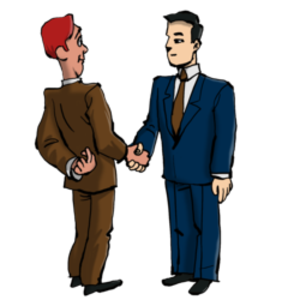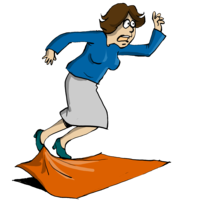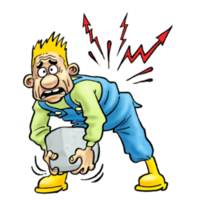The Cycles of Life

“The Book of the Heart: Embracing the Tao” (Loy Ching-Yuen)
“In moments of darkness and pain remember all is cyclical. Sit quietly behind your wooden door: Spring will come again.”
–Loy Ching Yuen (Chinese Taoist T’ai Chi Ch’uan Master, 1873-1960)
The Neurology of Fibromyalgia

Fibromyalgia can be a particularly nasty illness, not least because people who suffer from it have often been misdiagnosed and occasionally even accused of malingering. But the pain can be very real and very severe. There are some very good reasons for believing that it is a neurological problem involving regions of the brain and spinal cord that are involved in modulating pain.
A new study from the University of Bath and Royal National Hospital for Rheumatic Diseases in England has raised some intriguing possibilities for treatment. A year ago, researchers from the same institution reported that there is a reorganization of the sensory regions of the brain n people with chronic pain.
In this new study, researchers asked patients to look at a reflection of one arm while moving their other arm in a different direction that was hidden behind a mirror positioned in front of them at a right angle. So one limb was obscured from view behind the mirror while they could clearly see the other limb and its reflection.
This simple experiment created a mismatch between what the brain sees from sensory input and what it feels through the motor system that controls movement.
Of the 29 fibromyalgia patients involved in the study, 26 reported feeling a transient increase in pain, temperature change or heaviness in their hidden limb – all symptoms of a flare up of their condition.
This suggests that a mismatch between sensory and motor neurons could be at the root of the fibromyalgia.
This study adds to the growing body of evidence that many of the symptoms of fibromyalgia may be triggered or perpetuated by a sensory-motor conflict.
That opens up all kinds of new possibilities for treatment.
Ear Acupuncture and Knee Surgery

There is growing interest, particularly in Europe, about the use of acupuncture and acupressure in combination with conventional Western Medicine.
Researchers from Ernst Moritz Arndt University in Greifswald in Germany have reported the results of a study to see whether acupuncture would help 120 people undergoing surgery of the knee.
Their main measurement was the patients’ need for postoperative pain medication.
The patients were randomly received true auricular (ear) acupuncture at the main points that Chinese medicine says are important in treatment: the Lung, Shenmen and Knee points.
The control group had a sham procedure: they were “treated” at three non-acupuncture points on the outside of the ear: the auricular helix. The “real” and the “sham” treatments were given on the ear on the same side as the knee, before ambulatory knee arthroscopy. Permanent press needles were left in place for one day after surgery and post-operative pain was treated with ibuprofen. Pain intensity was similar in both groups at all time points, but those in the acupuncture group required significantly less post-operative ibuprofen than controls.
This fits with clinical experience and is a good first study.
Not only may this provide personal benefit for the patients, but if acupuncture can reduce post-operative costs, you can be sure that insurance companies are going to get very interested very quickly.
Fibromyalgia is Real! A Battle That Should Not Have To Be Fought Again

Fibromyalgia is a chronic, widespread pain in muscles and soft tissues accompanied by fatigue, it is a fairly common condition, affecting 3% to 6% of the general population, and is most commonly diagnosed in people between the ages of 20 and 50, though onset can occur in
childhood. The disease is not life-threatening, though the degree of
symptoms may vary greatly from day to day with periods of flares
(severe worsening of symptoms) or remission. The syndrome is generally
perceived as non-progressive, yet that issue is still a matter of debate.
The cardinal symptoms of fibromyalgia are chronic, widespread pain and
tenderness to light touch together with moderate to severe fatigue.
Those affected may also experience heightened sensitivity of the skin (“allodynia“),
tingling of the skin that is often needle-like, a deep ache in the muscle and , less often, the tendons, prolonged muscle spasms, weakness in the limbs, and nerve pain.
Chronic sleep disturbances are also characteristic of fibromyalgia, and
some studies suggest that these sleep disturbances are the result of a
sleep disorder called alpha-delta sleep , a condition in which
deep sleep (associated with delta EEG waves) is frequently interrupted
by bursts of brain activity similar to wakefulness (i.e. alpha waves).
Deeper stages of sleep (stages 3 & 4) are often dramatically
reduced, and that is the likely cause of the cognitive problems that so often accompany fibromyalgia.
There is not any structural damage in an organ, though it may sometimes start after trauma, such as a motor vehicle accident.
It is that last fact, that there is s often no obvious physical pathology, that has lead so many people to claim that fibromyalgia is “nothing more than” pain associated with depression. I have has some interesting “discussions” with health care professionals convinced that people wit fibromyalgia do not have a “real” illness, and that they need psychotherapy or antidepressants. Yet pain is pain, and the false dichotomy: “Is the pain my mind or in my body?” helps nobody.
Twenty-five years ago, Muhammad B. Yunus and his collaborators published the first controlled study of the clinical characteristics of fibromyalgia syndrome. That seminal article, published in Seminars in Arthritis and Rheumatism, led directly to formal recognition of this disease by the medical community. Last month, again in Seminars in Arthritis and Rheumatism, Muhammed makes another enormous contribution to the field of chronic pain and fatigue by meticulously synthesizing and interpreting the extensive body of scientific literature on fibromyalgia and his own insights into the concept of central sensitivity syndromes (CSS) that include irritable bowel syndrome, migraine and restless legs syndrome.
In fact there are at least 13 separate conditions that are related to central sensitization (CS), where the central nervous system becomes extremely sensitized with respect to certain parts of the body, so that even mild pressure or touch would cause much pain. This hypersensitivity may also be associated with other symptoms such as poor sleep and fatigue.
Muhammed took a rather more biological approach to fibromyalgia in the past, now emphasizes a biopsychosocial perspective:
“In my view, this is tremendously important because it is the only way to synthesize the disparate contributions of such variables as genes and adverse childhood experiences, life stress and distress, posttraumatic stress disorder, mood disorders, self-efficacy for pain control, catastrophizing, coping style, and social support into the evolving picture of central nervous system dysfunction vis-à-vis chronic pain and fatigue. Science and medicine now have rational scaffolding for understanding and treating chronic pain syndromes previously considered to be ‘functional’ or ‘unexplained.’ Neuroscience research will continue to reveal the mechanisms of CS, but only if informed through a biopsychosocial perspective and with the interdisciplinary collaboration of basic scientists, psychologists, sociologists, epidemiologists, and clinicians.”
One of the reasons that I so like this new version of his model is because it fits so well with the concept of “Salience Disruption Syndrome.” A fancy name for a common problem that I talk about in Healing, Meaning and Purpose.
So very many people are super-sensitive to the environment and also have trouble in filtering out and deciding what is important. As a result pain, attentional problems, impulse control disorders, addictions and several other things tend to cluster together.
Happily we now have an array of novel techniques for dealing with these problems, and I plan to put out more books and papers on ways in which we can help.
Mindfulness and Depression

Mindfulness meditation has rightly been receiving a lot of attention recently. It is quite simply a technique in which you become intentionally aware of your thoughts and actions in the present moment, non-judgmentally. Though originally a Buddhist technique, it is something that can be practiced by anyone, and there are, in fact, similar techniques that have been developed by Christian mystics and Sufis.
It has recently been discovered that some of the techniques that were developed so that a mystic or meditator could carry on without distraction, may also have value in treating clinical problems. After all, if a group of people has spent a thousand years developing tools and techniques for managing the mind, it might be a good idea to see what they have discovered!
There have recently been several excellent books on the use of mindfulness in the management of depression:
The Mindful Way Through Depression
Relaxation, Meditation and Mindfulness
Mindfulness and Acceptance: Expanding the Cognitive-Behavioral Tradition
This whole field was moved forward by some research from San Francisco (NR822) that was presented at the end of May at the 2007 Annual Meeting of the American Psychiatric Association in San Diego. The researchers used Mindfulness-Based Cognitive Therapy (MBCT) in a group of 53 people with treatment resistant depression.
MBCT is based on the Mindfulness-based Stress Reduction (MBSR) eight-week program that was developed by Jon Kabat-Zinn in 1979 at the University of Massachusetts Medical Center. Research has show that MBSR can be enormously empowering for people with chronic pain, hypertension, heart disease, cancer, and gastrointestinal disorders, as well as for psychological problems such as anxiety and panic.
Mindfulness-based Cognitive Therapy grew from this work. Zindel Segal, Mark Williams and John Teasdale adapted the MBSR program so that it could be used for people who had suffered repeated episodes of depression.
The results of the study presented in San Diego showed that MBCT was effective in reducing depression when compared to treatment as usual: what we call “TAU.” What seems to happen is that MBCT gives people a set of skills for detaching from the stream of depressive thoughts and feelings. As a result the symptoms decrease. Though the study will need to be expanded and replicated, this is clearly a fertile area for research.
This work is also interesting in the light of recent research showing that mindfulness training may improve the activity of some of the subsystems of the brain dedicated to attention, as well as helping some people with mental illness control their aggressive behavior. Mindfulness training may also help to reduce subjective reduces distress and improves positive mood states. It seems to be particularly good at reducing distracting and ruminative thoughts and behaviors.
And just for good measure, mindfulness may help some smokers quit.
“The purpose of meditation is not enlightenment, it is to pay attention even at extraordinary times, to be of the present, nothing-but-in-the-present, to bear this mindfulness of now into each event of ordinary life.”
–Peter Matthiessen (American Naturalist and Writer, 1927-)
“Meditation is not to escape from society, but to come
back to ourselves and see what is going on. Once there is
seeing, there must be acting. With mindfulness, we know
what to do and what not to do to help.”
— Thich Nhat Hanh Vietnamese Buddhist Monk, 1926-)
“Conscious means “having an awareness of one’s inner and outer worlds; mentally perceptive, awake, mindful.” So “conscious business” might mean, engaging in an occupation, work, or trade in a mindful, awake fashion. This implies, of course, that many people do not do so. In my experience, that is often the case. So I would definitely be in favor of conscious business; or conscious anything, for that matter.”
–Ken Wilber (American Philosopher, 1949-)
Motivation, Manipulation and Empowerment

It would be good to know how many people really change after they’ve done one of those motivational seminars. Undoubtedly some do, but most do not.
This stands in stark contrast to inspirational speakers who often change people for life.
If you try to “motivate” an adult to change their behavior, after an initial brief period during which they get excited about what they are learning, they will most likely resist what they perceive as manipulation. People who do change normally don’t maintain the new behavior because the primary motivation was external.
If we are trying to help people eat a more healthy diet, or take some exercise, research has shown that the best way to initiate and maintain a new behavior is for an individual to have an expert who can teach, guide and facilitate. That together with a peer supporter: someone who will help you along, and diet and exercise with you. You know yourself better than anyone else ever can.
The trick is to work with someone who may know a bit more about psychology, physiology and metabolism and can use that information to help you to develop a personalized program. The expert can help you move forward by asking question to identify your own motivators, locus of control (do you feel that you are the captain of your own ship, or do you believe that you are more a plaything of fate?) ego-fears, reward system and action style (do you like to break tasks down into small steps and work at one at a time in sequence, or do you like to work on one task, then pull out something else that like to do and do you have some other way of getting things done?)
There was recently a study from the UK that showed that the behavior of children with special needs was improved by a good diet and regular exercise. No surprise there. But the problem is this: how do you maintain the diet and exercise programs?
I spent many years working with young people with weight problems and/or diabetes. They usually also had some mood or behavioral problems. Issuing young people with a great long list of “Thou shalt nots” is guaranteed to backfire: youngsters are rebellious anyway. Tell them all the things that they can’t do, and force them into eating a certain way, and you will have a rebellion on your hands that will make the Storming of the Bastille look like a picnic. It is much better to come to an agreement that may include having days on which they can “cheat.”
A while ago I wrote about the way in which psychologists have moved beyond the pain/pleasure dichotomy as the major motivators of human behavior. Rewards and punishments are called extrinsic motivators, while intrinsic motivators are a composite of genes, learning, environment and temperament. I gave a few examples of motivators culled from the current literature:
- Clarity of vision
- Encouragement
- Personal engagement
- Recognition
- Pride
- Free flow of energy and information
- Appropriate reward systems (money is often not the best one!)
- Personal and group expectations
- Creating shared goals
- Transpersonal motivation: Inspiration and leaving a legacy.
I had several excellent questions: couldn’t people practice altruism because it gives them pleasure? Yes, they could, but that is not what the research data shows. Though people can derive pleasure from all kinds of things, the evidence base suggests that human motivations are far more complex.
It has also become possible to visualize regions of the brain while people are engaged in different tasks, and altruism does not seem to engage most of the circuits that we normally associate with pleasure or pain.
Yet more evidence that pleasure and pain and far from being the only – or maybe even the main – motivators of human behavior.
“No one ever does anything from a single motive”
–Samuel Taylor Coleridge (English Romantic Poet, 1772-1834)
“No one can motivate you, until you motivate yourself.”
–Jawaharlal Nehru (Indian Politician and Statesman, 1889-1964)
“Motivation is everything. You can do the work of two people, but you can’t be two people. Instead, you have to inspire the next guy down the line and get him to inspire his people.”
–Lee Iacocca (American Businessman and Former CEO of Chrysler, 1924-)
“Motivation is what gets you started. Habit is what keeps you going.”
–Jim Rohn (American Businessman, Author, Speaker and Philosopher)
“Do not brood over your past mistakes and failures as this will only fill your mind with grief, regret and depression. Do not repeat them in the future.”
–Sri Swami Sivananda (Indian Physician and Spiritual Teacher, 1887-1963)
“The need for devotion to something outside ourselves is even more profound than the need for companionship.”
–Ross Parmenter (American Expert on Mixtec Documents, Journalist and Music Reviewer for the New York Times, 1920-1999)
“He who wishes to secure the good of others has already secured his own.”
–Confucius (Chinese Philosopher, 551-479 B.C.E.)
Back Pain, The Brain and Pain Cycles

A German research team using a specialized imaging technique called diffusion tensor imaging (DTI) to look at the differences between back pain sufferers’ and healthy volunteers’ brains found that individuals suffering from chronic low back pain also had micro-structural changes in their brains. The findings were presented at the annual meeting of the Radiological Society of North America in Chicago by the lead researcher Dr Jurgen Lutz, a radiologist at Ludwig-Maximilians University in Munich, Germany.
DTI tracks the movement of water molecules in the brain’s gray and white matter. Individual water molecules are constantly in motion, colliding with each other and other nearby molecules, causing them to spread out, or diffuse. DTI allows us to analyze water diffusion in the tissues of the brain. In normal white matter, water diffuses in only one direction. So if they are moving in the “wrong” direction, we can use this as an indication that there are changes in the fiber pathways.
The investigators studied 20 patients who were experiencing chronic back pain with no precisely identifiable cause and 20 age- and gender-matched healthy volunteers. DTI was performed to measure the diffusion in several areas of each patient’s brain.
They discovered the brains of patients with chronic back pain had a more complex and active microstructure compared with the healthy volunteers’ brains.
The changes were found in regions of the brain associated with pain-processing, emotion and stress response, including the cingulate gyrus, postcentral gyrus and superior frontal gyrus.
Although it is possible that theses structural disturbances are a cause of chronic pain, it is more likely to be the other way round.
This leads us to a very important concept that is not talked about as much as it should be: it is the idea of pain cycles. Pain cycles can have a physical or psychological origin and are thought to be maintained by some of the centers in the brain that process pain and emotional distress. The two are often mixed together: pain is extremely common in both depression and in bipolar disorder, and pain can, of course, make you feel depressed.
Theses pain cycles will often persist for long periods after the original cause of the pain has gone. So we may continue to feel pain long after a broken bone has healed, or we may continue to suffer emotionally long after a bad relationship should have been dead and buried. Many interventions like acupuncture or injecting steroids or anesthetics into trigger points can interfere with the pain cycle. Similarly there are many therapies, including some of the tapping therapies, that seem to “re-set” some of the systems in the nervous and subtle systems of the body.
In my forthcoming book Sacred Cycles, I talk a lo about these vicious pain cycles and how to interrupt them.
“Pain is part of being alive and we need to learn that. Pain does not last forever, nor is it necessarily unbeatable, and we need to be taught that.”
–Rabbi Harold S. Kushner (American Rabbi Aligned with the Progressive Wing of Conservative Judaism and Writer, 1935-)
“Softness is a dream in every ache to become a better soul.”
–John Kells (Irish-born British Grand Master of T’ai Chi Ch’uan, 1940-)
Arthritis and Sex
Today being Valentine’s Day (you did remember didn’t you?), Arthritis Care in the United Kingdom has taken the opportunity to publicize its free booklet on sex, relationships, intimacy and arthritis, downloadable from its website (pdf).
Integrated Medicine is all about empowering and caring for the whole person, so I was very pleased to see this document. I spent some very happy times helping people with various types of arthritis, and I was astonished how infrequently anyone had ever asked them about the ways in which the illness impacted normal daily activities and had ever given them any advice on ways to work around problems.
Let me quote form the Arthritis Care news release:
"One of the reasons we produced the guide is to address issues people felt awkward discussing. It may be embarrassing to talk to your consultant rheumatologist, nurse or GP about emotional and sexual things, or matters of self-image and self-esteem – and they may be embarrassed to be asked. So where do you turn?’ said Kate Llewelyn head of publications at Arthritis Care, who was diagnosed with rheumatoid arthritis at the age of thirteen.
The booklet provides a valuable insight for healthcare professionals and for the partners and families of people with arthritis, highlighting issues of concern to them, and suggesting practical and achievable solutions.
For people with arthritis, or other disabilities, difficulty can start before any relationship, pre-dating any date.
‘Managing pain and other symptoms is exhausting, and it stops many people getting out and socializing. As a result, arthritis can be isolating, keeping you from making friends or seeing family, let alone dating and finding a partner. And maybe you are not very mobile, so can’t dance, or play sport, or can’t drink because of your medications. What’s more, although anti-discrimination law means venues must now offer better access for disabled people, you still may find it harder to do things people without arthritis take for granted’, said Kate Llewelyn.
Once a relationship has been formed, the challenges continue; the couple must work out ways of ensuring their personal and sexual relationship is sustained and developed, overcoming and working round the incurable and debilitating condition.
The report discusses a number of very practical matters: how pain and also medication can interfere with sex drive and some can cause weight gain. Many forms of arthritis are also associated with anemia and/or chronic fatigue.
It also discusses some of the psychological factors that can interfere with the sex lives of arthritis sufferers. For example, men may feel emasculated if they cannot perform their ‘traditional’ roles like playing sport or carrying heavy objects. Women may feel unfeminine if they put on weight with steroids, cannot do the housework or lift their children as a result of having arthritis. Others, with limited joint movement, or severe pain may be put off sex altogether, or find some of the traditional sex positions too uncomfortable.
‘The book has got diagrams of lovemaking positions which people of differing physical abilities and limited movement have found useful. If you’ve got problems with your spine, or hips, or knees, it makes sense to experiment with positions that place least weight or strain on the rogue joints. Of course, after joint surgery or replacement, you may be advised to take a temporary break from sex, but, relationships are more than sex, and, with this guide, abstinence may make the heart grow fonder’, said Kate Llewelyn.
Sex is rarely discussed with people strugglig with chronic illness, often because health care providers get embarassed about it.
It is essential for that to change, and I want to say a big thank you to Arthitis Care for having the courage to do this.
Temporomandibular Joint Dysfunction and Posttraumatic Stress Disorder

Over the last few years I’ve had the privilege of visiting Croatia several times. I was one of the first Western academics to go back there to teach after the war, and I’ve made many good friends. It is a beautiful country with lovely people and it is a terrible shame what happened there.
One of the big problems that remain is the incredible number of people suffering from posttraumatic stress disorder (PTSD). There continues to be some debate about whether PTSD can only occur in response to one major traumatic event in which a person feels that their life is in danger, or whether it can also occur as a result of repeated less serious traumata. We have discussed the relationships between PTSD, resilience and neurological dysfunction, and of the association between PTSD and laterality.
There has also been at least one report of an association between PTSD and atypical facial pain.
A new paper from colleagues in Croatia has clarified this association by showing that people with PTSD are at increased risk of temporomandibular muscle and joint disorder, or TMJD, which used to be known simply as temporomandibular joint (TMJ) dysfunction. This is intuitively obvious, but it is an important finding. The main complaint was of headache, and it is important not to dismiss these headaches as migraine, tension headaches or as some kind of somatization.
There is currently an $8 million project underway to establish valid and reliable TMJD diagnostic criteria. It is to be hoped that the results of the study will advance the field of TMJD research and aid clinicians in their practices. At a meeting of the American Association of Dental Research in Orlando, Florida in March, Richard Ohrbach from the University of Buffalo presented data from the study indicating that 82% of People whose recurrent headaches have been diagnosed as tension-related actually had TMJD.
In April of this year, we had the first meeting of the National Institutes of Health Pain Consortium. There’s a good report in Clinical Psychiatry News about ongoing studies from the University of Washington in Seattle. Niloofar Afari presented data that confirms the findings in the Croatian study. And provides yet more useful information.
The investigators used state records to identify twins and surveyed more than 1,700 female twins by mail and by telephone. The results so far indicate that the association between PTSD and TMJD is real and that there may be a genetic predisposition to the association.
It is important not to miss this possible association. Misdiagnosis can cause a lot of needless suffering.
How to Stick a Knife Through Your Arm
I know that probably sounds a bit gross, but sometimes Nature does our experiments for us.
And this particular experiment involved a young Pakistani boy who worked as a street "entertainer" by sticking sharp objects into various parts of his anatomy. He was able to do this not because of some form of religious fervor or yogic control, but because he had a congenital inability to feel pain.
That may sound like a good thing but it is not. Pain exists to warn you: how else would you know is you have stepped on broken glass or put your hand on a hot plate?
Investigators on three continents collaborated to track down the boy’s problem at the molecular level. The research is published in the journal Nature, and will likely open up a whole new approach to treating pain.
The boy dies four years ago at the age of fourteen, but the investigators were able to track down six of the boy’s extended relatives who were also totally numb to pain. However they had some feeling: a pinprick would feel like pressure. They all had frequent cuts and bruises and problems using their limbs, and they all had old injuries to their lips or tongues from biting themselves as young children.
Since the late 1990s researchers have been studying the culprit gene product, a sodium-conducting ion channel called NaV1.7, which sits on the ends of pain-sensing cells. In 2004 researchers in China identified members of two families who have a nasty condition called erythromelalgia, in which the slightest warmth causes literally burning pain in their hands and feet.
Work by the group in China and Stephen Waxman’s group at Yale in West Haven, Connecticut, discovered that the cause of this condition is a mutation in the NaV1.7 channel that makes it become hyperactive. In effect the mutated channel overstimulates pain-sensing neurons, causing them to register pain more frequently. By contrast, the mutation in the pain-free Pakistanis knocks out NaV1.7 activity, so no firing of the pain-sensing neurons.
This work will inevitably lead to a search for new ways of damping down pain. Now that we have a good idea of the way in which a single mutation can either cause too much pain or none at all, the nest step is to see if we can deelop comprehensive treatment strategies based on these new insights.






